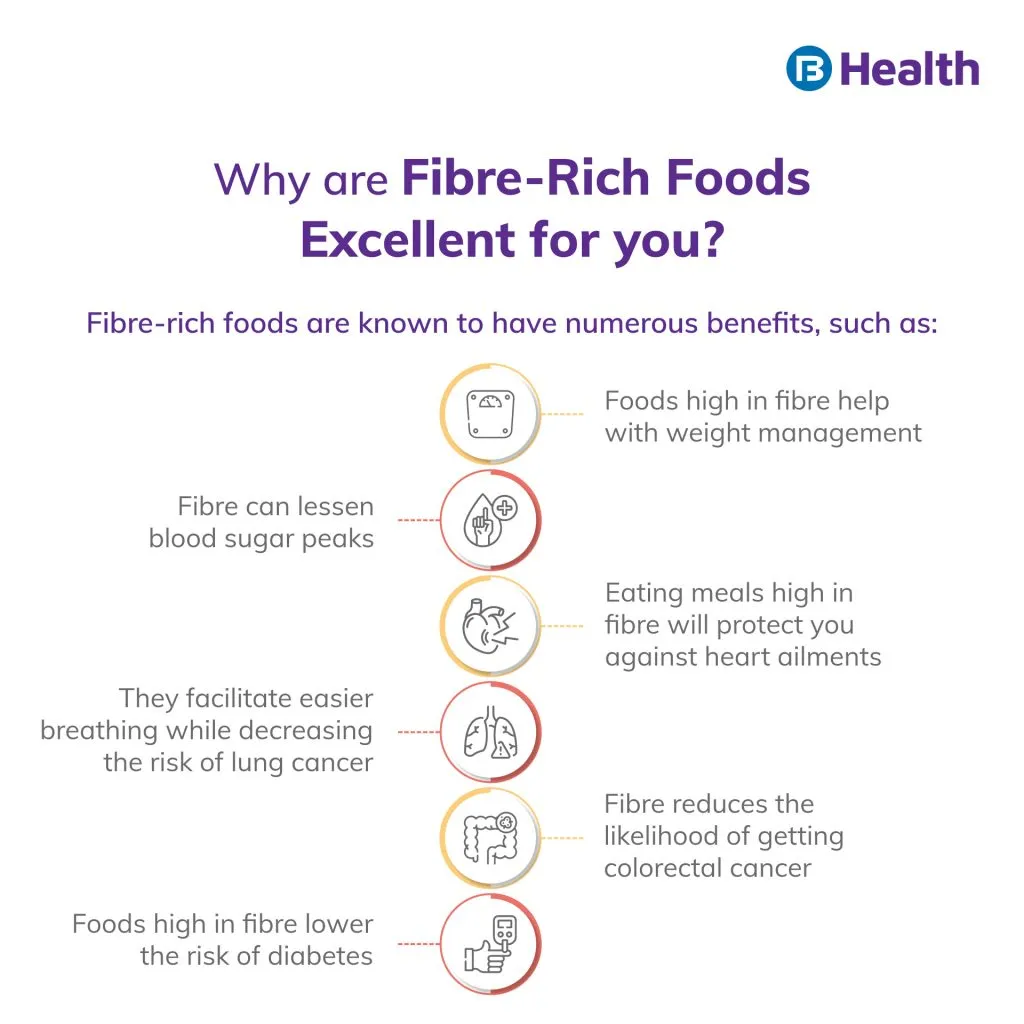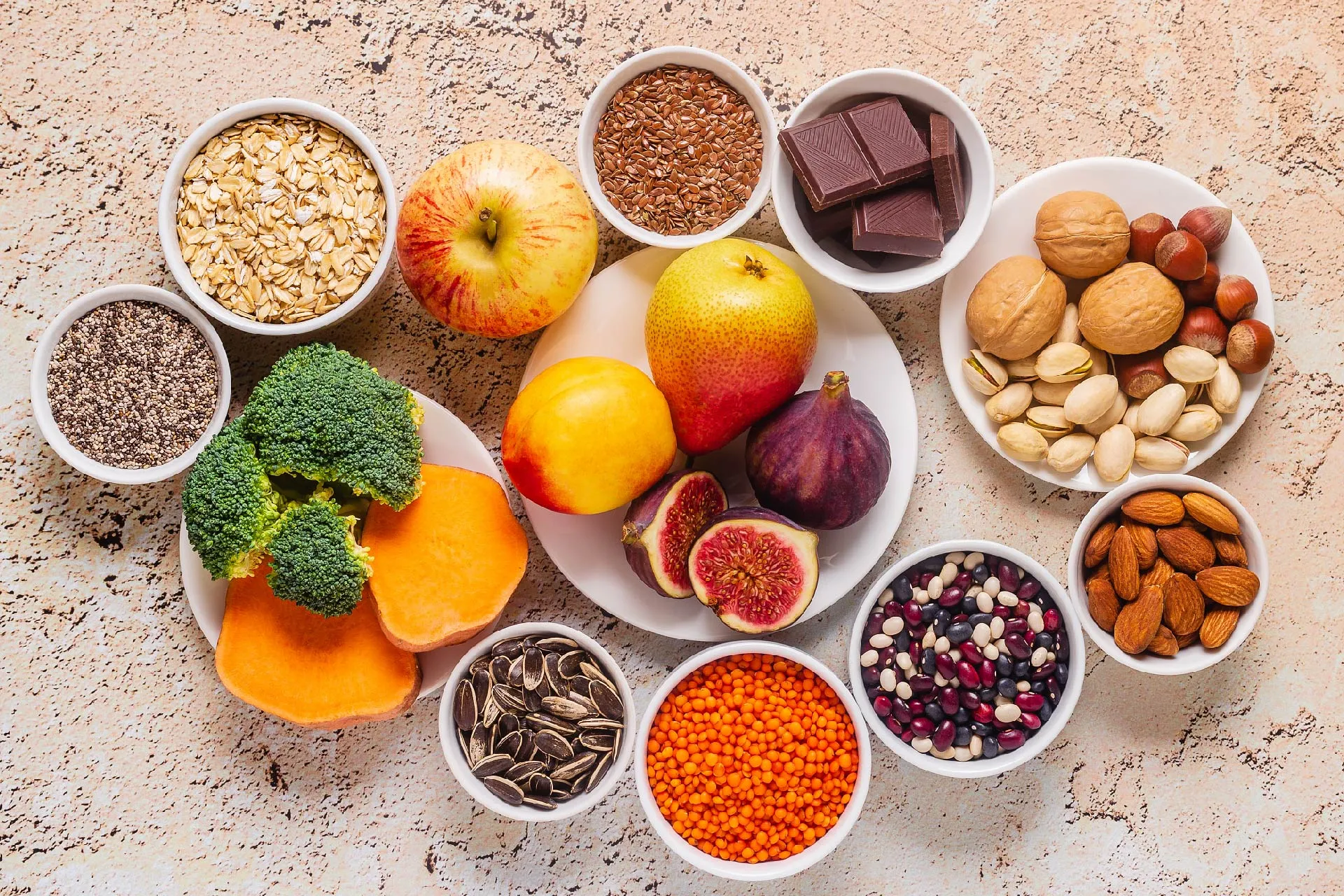Nutrition | 9 min read
30 Fibre Rich Food For An Incredible Digestive Health
Medically reviewed by
Table of Content
Synopsis
You've undoubtedly heard how crucial fibre is for your body if you're attempting to change your eating habits or drop a few pounds. For starters, it keeps you fuller for longer, allowing you to cut back on needless afternoon eating. However, fibre has several other health advantages.
Key Takeaways
- Fibre rich food aid in the prevention of certain diseases like diabetes and cardiovascular diseases
- Fibre is a vital ingredient that may help with weight reduction, blood sugar control, and constipation
- It is required for excretion and healthy gastrointestinal health
Fibre-Rich Foods- 30 Fruits and Vegetables
In this blog, we've compiled a list of foods high in fibreand fruits high in fibre. The advantages of consuming both fruits and vegetables high in fibre are plenty. The fibre rich food, vegetables and fruits are listed as follows:
Pears (3.1 grams)
- The pear is a popular fruit that is both nutritious and tasty. This fruit ranks among the best sources of fibre. It is a fibre rich food
- A medium-sized, uncooked pear has 5.5 grams of fibre or 3.1 grams per 100 grams
Strawberries (2 grams)
- It is a fibre rich food
- Fresh strawberries are a delightful and healthy food option
- Interestingly, they score high among fruits in terms of nutritional density, with high quantities of vitamin C, manganese, and other powerful antioxidants. Try it in this smoothie with bananas and strawberries
- Fresh strawberries have 3 grams of fibre per cup or two tablespoons per 100 grams
Avocado (6.7 grams)
- Avocado is a rare fruit. Rather than being high in carbs, it is high in beneficial fats and is a fibre rich food
- Avocados are high in vitamin C, potassium, magnesium, vitamin E, and numerous B vitamins. They also offer several health advantages. Try them in scrumptious avocado dishes [1]
- 1 cup of raw avocado has 10 grams of fibre or 6.7 grams per 100 grams
Apples (2.4 grams)
- An apple is one of the most delightful and satisfying foods you can eat. It is definitely a fibre rich food
- We particularly enjoy them in salads
- The amount of fibre in a medium-sized raw apple is 4.4 grams or 2.4 grams per 100 grams
Raspberries (6.5 grams)
- Raspberries have a strong flavor and are high in nutrients, and it is a fibre rich food. They include a lot of magnesium and vitamin C
- For this raspberry tarragon dressing, take raspberries with shallots, olive or canola oil, add salt and blend in with the fruity vinaigrette of your choice
- 8 grams of fibre, or 6.5 grams per 100 grams, may be found in one cup of raw raspberries
Bananas (2.6 grams)
- Bananas are high in nutrients such as vitamin C, vitamin B6, and potassium. It has high fibre content and is called a high fibre rich food
- Green or unripe bananas contain a high concentration of carbohydrates, a non - digestible carbohydrate that acts as fibre. You can also utilise them to add energy to any nut butter sandwich
- A medium-sized banana has 3.1 grams of fibre or 2.6 grams per 100 grams

Guava
- Guava reduces blood sugar levels and decreases insulin resistance. This wonderful tropical fruit also contains 9 grams of fibre
- It reduces diarrhoea and constipation
- Adding Guava to your diet can aid you in regularizing your bowel movements
Pomegranate Arils
- Per cup serving, there are 7 grams of fibre in this fibre rich food
- The anti-inflammatory qualities of pomegranate arils (or seeds) may enhance skin quality for anti-ageing advantages
Blackberries
- It contains 7.5 grams of fibre per serving of one cup
- Blackberries have a lot of fibre, just like raspberries do. You may eat these raw by the handful, in yoghurt, or as part of a fruit salad, whether they are fresh or frozen
Carrots (2.8 grams)
- Carrots are nutritious fresh vegetables that are tasty and crispy. They also come under fibre rich food
- It's high in vitamin K, vitamin B6, magnesium, and beta carotene, a protective agent your body converts to vitamin A
- You can add some chopped carrots to your subsequent vegetable-heavy soup
- Carrots contain 2.8 grams of fibre per 100 grams or 3.6 grams in 1 cup of raw carrots
Beets (2.8 grams)
- Beets, often known as beets, are root vegetables rich in several vital minerals, including folate, iron, copper, manganese, and potassium
- Additionally, beets are rich in inorganic nitrates, which have been linked to a number of advantages for controlling blood pressure and enhancing athletic performance
- Try them in this salad of beets and lemon-dijon dressing
- Beets provide 3.8 grams of fibre per cup when they're raw or 2.8 grams per 100 grams
Broccoli (2.6 grams)
- A cruciferous vegetable, broccoli is one of the world's foods with the highest nutritional density
- It's packed with antioxidants, powerful cancer-fighting minerals, and vitamin C, vitamin K, folate, B vitamins, potassium, iron, and manganese
- In comparison to most vegetables, broccoli also has a higher-than-average protein content
- Fibre content is 2.4 grams per cup or 2.6 grams per 100 grams
Artichoke (5.4 grams)
- The artichoke doesn't garner much media attention. However, this vegetable is abundant in many nutrients, and it is the best fibre rich food in the world
- Wait till you give them a try and eat it roasted
- French artichoke or globe uncooked has 6.9 grams of fibre or 5.4 grams per 100 grams
Belgian spuds (3.8 grams)
- The brussels sprout is a broccoli-related cruciferous vegetable
- They contain significant amounts of vitamin K, potassium, folate, and strong cancer-preventive antioxidants
- Consider roasting Brussels sprouts with apples and bacon or serving them with balsamic vinegar drizzle
- A cup of raw Brussels sprouts has 3.3 grams of fibre or 3.7 grams per 100 grams
Mung beans (6.8 grams)
- Legumes of the kidney bean kind are very common. They include a lot of different minerals and plant-based proteins, much like other legumes
- 12.2 grams of fibre, or 6.8 grams per 100 grams, are present in one cup of cooked beans
Lentils (7.3 grams)
- Lentils are a low-cost, high-nutritional-value food
- Cumin, coriander, turmeric, and cinnamon flavour this lentil soup
- You get 13.1 grams of fibre per cup of cooked lentils or 7.3 grams per 100 grams
Divided peas (8.3 grams)
- Pea seeds that have been dried, split, and peeled are used to make split peas. Split pea soup often has them after holidays with ham
- Cooked split peas include 16.3 grams of fibre per cup or 8.3 grams per 100 grams
Chickpeas (7 grams)
- Chickpeas are another type of bean that is high in nutrients such as minerals and protein
- Chickpea, one of the simplest spreads to prepare at home, is made from chickpeas. It's great on salads, vegetables, whole grain bread, and more
- 12.5 grams of fibre per serving of cooked beans, or 7.6 grams per 100 grams
Quinoa (2.8 grams)
- Pseudo-cereal quinoa has gained enormous popularity among health-conscious consumers in recent years
- It contains a wealth of minerals, including, among others, protein, magnesium, iron, zinc, potassium, and antioxidants
- 5.2 grams of fibre are included in one serving of cooked rice or 2.8 per 100 grams
Oats (10.1 grams)
- One of the healthiest grains and fibre rich foodin the world is oats. They are rich in vitamins and minerals, minerals, and antioxidants
- They include beta-glucan, a strong soluble fibre that has significant benefits for sugar levels and high cholesterol
- Overnight oats are now a go-to for quick breakfasts
- 16.5 grams of fibre per cup of uncooked oats, or 10.1 grams per 100 grams
Pinto Beans
- The fibre content of pinto beans is 15 grams per cup [2]
- Pinto beans include a lot of fibre, which will keep you feeling full for longer. They are a great source of protein and have a ton of fibre. They can be added to stews and soups, sprinkled on salads, or used in tacos and burritos in place of meat
Soybeans (Edamame)
- This fibre-rich food has 11 grams of fibre in one cup per serving
- According to Farrell Allen, soybeans contain significant amounts of phytoestrogens that may assist in lessening or treating menopausal symptoms like hot flashes. They can be used similarly to other beans or eaten as a snack
Greens with Collards
- You get 6 grams of fibre per 1 cup serving
- The high fibre rich food cooked collards are ideal for stewing in the typical southern way or adding to a hearty fall or wintertime soup
Fibre from whole-grain spelt
- From a cup serving of whole-grain spelt, you get 7.5 grams of fibre
- Spelt has a wonderfully nutty taste and chewy texture, making it an excellent grain alternative
Cauliflower
- A tiny floret of cauliflower consists of 5 grams of fibre
- Although cauliflower makes a terrific snack, it also tastes delicious when roasted with chickpeas and garlic and then added to spaghetti. Or use it in place of potatoes by roasting and mashing it
Sweet Potatoes
- Per one-cup serving, there are 4 grams of fibre
- Sweet potatoes are a wonderful method to increase your fibre intake, and they're also an "amazing" source of vitamin A, which is good for your vision
- Sweet potatoes may be substituted in almost any potato recipe
- Then, spread your favorite toast toppings, such as peanut butter, banana, and honey.
Lima Beans
- One cup serving of lima beans gives you 11.5 grams of fibre
- The best way to consume all the fibre in lima beans is frozen or canned; combine it with corn to create a flavorful succotash
Green Leafy Vegetables
- Leafy greens like spinach and kale are abundant in fibre and nutrients, including folate, vitamin C, vitamin K, and vitamin A
- Leafy greens contain a kind of sugar that encourages the establishment of beneficial intestinal bacteria
- Eating enough fibre and leafy greens promotes the development of healthy gut microbiota — the billions of organisms that reside in the colon [3]
Onions
- One cup of onion has 9 grams of fructan content
- Make a fresh fruit mixture using onion, mango, lime juice, and cilantro for a delicious meal
Asparagus
- Five spears of asparagus have five grams of fructan content
- You can slice raw asparagus sticks over a simple salad using a vegetable peeler

Benefits of Eating Fibre-rich Food
Aids in blood sugar regulation
Fibre, especially soluble fibre, can help control blood sugar levels in people with diabetes by slowing the absorption of sugar. In addition, insoluble fibre may help lower the risk of type 2 diabetes by eating a nutritious diet. It helps one reach a healthy weight
You will probably eat less and feel fuller longer if you consume high-fibre meals instead of low-fibre ones since they are usually more satisfying. Additionally, high-fibre meals take longer to consume and are less ‘energy dense,’ which means they contain fewer calories per unit of food.
Prolongs your life
According to studies, increased dietary fibre consumption, particularly from cereal, may lower your chance of dying from all malignancies and cardiovascular disease. [4]
Fibre rich foods are beneficial to your health. However, introducing far too much fibre too soon might cause stomach bloating, cramps, and intestinal gas. Over a few weeks, gradually increase your fibre intake. This allows the normal microbes in your digestive system to adjust to the change.
Drink a lot of water as well. The greatest way for fibre to act is to absorb water, which will result in soft, thick stools.
Bajaj Finserv Health provides consultation with a general physician for you and your family. With Bajaj Finserv Health, you can choose the best physicians in your area, set up an online doctor consultation and get reminders for taking your medications. You can also save all of your medical information in one location.
References
- https://www.loveandlemons.com/avocado-recipes/
- https://health.gov/our-work/nutrition-physical-activity/dietary-guidelines/previous-dietary-guidelines/2015
- https://www.ncbi.nlm.nih.gov/pmc/articles/PMC6041804/
- https://www.ncbi.nlm.nih.gov/pmc/articles/PMC5731843/
Disclaimer
Please note that this article is solely meant for informational purposes and Bajaj Finserv Health Limited (“BFHL”) does not shoulder any responsibility of the views/advice/information expressed/given by the writer/reviewer/originator. This article should not be considered as a substitute for any medical advice, diagnosis or treatment. Always consult with your trusted physician/qualified healthcare professional to evaluate your medical condition. The above article has been reviewed by a qualified doctor and BFHL is not responsible for any damages for any information or services provided by any third party.
